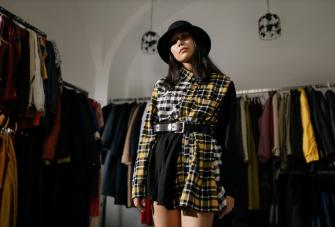How to Start a Clothing Business
If you’ve ever thought of starting your own clothing line, but aren’t sure where to begin, then you’ve come to the right place. We take you through the process of starting a clothing line, including creating a good business plan, building a strong brand, and satisfying tax and legal requirements.
Have a Plan
Even if it’s the last thing you want to do, any successful clothing brand starts with a good business plan. For a clothing line business, your plan should include:
- The type of clothing you want to sell (casual, formal, a mix of both)
- How you intend to sell (online store or brick-and-mortar storefront)
- Your target market (men, women, children, androgynous, athletes, etc.)
- How much money you’ll need to get started
- Marketing strategies and budget
- Scaling up your business
Don’t underestimate the power of social media when it comes to marketing your fashion line—and tap into any influencers you know or who may be interested in the type of clothing you want to design. Their stamp of approval can go a long way in promoting your line at a minimal cost.
Not only that, but having a well-crafted business plan will help you find quality investors and a good manufacturing partner or retail partner, depending on your needs.
Many countries offer online support to new business owners, including the U.S., the UK, Canada, Nigeria, and Australia, to name a few. Search your government website for funding sources, business plan templates, registration requirements, and more.
Now that you’ve got a good plan in place, you’re ready to register your business.
Register Your Business
While it’s tempting to start selling clothes right away, you can’t legally operate a business in most countries without first registering with the government.
Luckily, you can register online in Canada. While registration requirements vary by location, most local governments require:
- Completion of registration paperwork
- Payment of a registration fee
- Obtaining a Canadian business number
- Obtaining a specialized license or permit to operate in the clothing industry, especially if you’re importing or exporting goods
The entire registration process can take several days to several months, depending on the location of your business, the number of permits/licenses required, and whether you can register online or must submit paperwork through the mail or a courier service.
While you’re waiting to receive your approved registration documents back, or once you’ve actually received them, you can begin working on your brand identity.
Create Your Brand Identity
An easily recognizable brand is crucial in the fashion industry. In fact, it may be the driving factor in how potential customers feel about your clothing company.
Your brand encompasses many things, including:
- A brand name (what will your company/clothes be called?)
- Logos/graphics
- Consistent design across print and digital media
- Your company’s story—what your company’s about (sustainability, offering a hand up, etc.) and how you got here
- The boiled down essence of you, your company, and your clothing
Your brand is the first impression partners, manufacturers, retailers, and consumers will have of you and your company.
It’s a good idea to keep your target audience in mind when working on your brand, too. A clothing company focused on children’s wear will have a completely different brand identity than a lingerie company.
Design Your Pieces
At last, you’re finally at the fun part—designing the pieces that will be in your initial collection! You can choose to do this in a variety of ways, depending on your goals as an entrepreneur.
The least expensive option is purchasing premade clothing, having your graphic designs added to the garment (t-shirt, sweats, hoodie, etc.) then reselling it, also known as print-on-demand.
Next in cost is custom wholesale, where you still purchase garments in bulk but you do the actual modification to the fabric, such as embroidery or adding embellishments.
Finally, the most expensive option is creating custom designs—you select the fabric, create the design, and have the entire garment made for you, also known as cut-and-sew in fashion businesses.
Select a Supplier or Manufacturer
If you’re simply starting with print-on-demand, then you have many inexpensive options, such as Custom Ink, apliiq, and Art of Where, to name a few. Confirm that the business you choose can handle high-volume, high-quality print orders fairly quickly, so you don’t leave your customers with a long wait or a substandard product.
Custom wholesale is also fairly easy to source since many companies offer wholesale garments in bulk. And, since they aren’t altering the clothing, you don’t have to worry about design turnaround times. You’ll need to ensure the fabric is durable enough to handle stitching or embellishment without stretching, tearing, or discoloration.
If you’re a designer with a cut-and-sew business, you’ll need to put the most effort into finding a manufacturing partner. In a perfect world, you’d travel to each potential manufacturer’s location to see their operation.
However, because many clothing manufacturers are located in Asia, it may be too difficult or expensive to travel to the location in person. In that case, see if the company will send a video of their operations and facilities, and video conference when possible.
Price Your Pieces
It’s finally time to price the individual pieces in your collection. This has to be based on more than just a gut feeling. You’ll need to factor in how much it costs you to create each piece, including manufacturing and materials.
Then you’ll need to look at what your competitors are selling their pieces for. If you’re overpriced compared to the market, your clothes won’t sell, no matter how much better they are than the competition. But if you price your items too far below the market price, you’ll lose revenue.
You may also want to get feedback from a test market, family, or friends to see if your prices are reasonable and will earn you enough to cover manufacturing expenses, start up costs, and employee wages, if applicable.
Read our guide on retail profit margins for more assistance.
Business Essentials
Once your clothing store is ready to open, you need to check off a few items to ensure it is successful. From hiring staff to decorating your store, you will need to take care of some odds and ends before launch. On top of this, you will want to spread the word about your clothing business through a strong marketing campaign.
Most importantly, you will need the right technology to power your business. And when it comes to stores, few things are more influential than a point of sale system. These devices manage all aspects of your store, from ringing up sales to managing inventory.
Epos Now offers a variety of POS systems for retailers, including desktop, tablet, and handheld devices. We also partner with payment processing companies and e-commerce platforms so you can sell to anyone, anywhere.
Call today to see how Epos Now can help get your clothing store off the ground!



